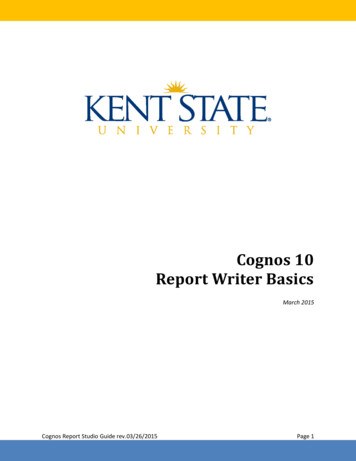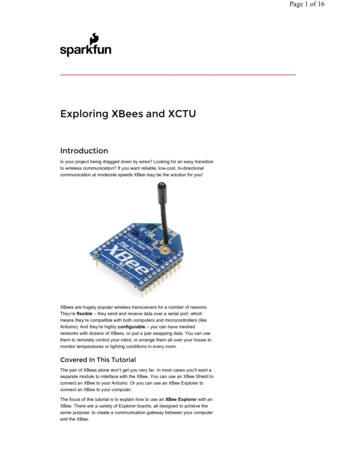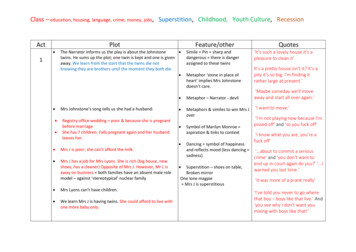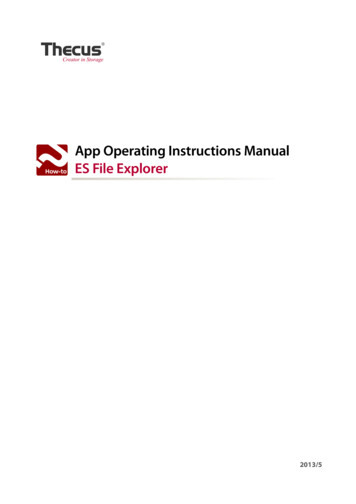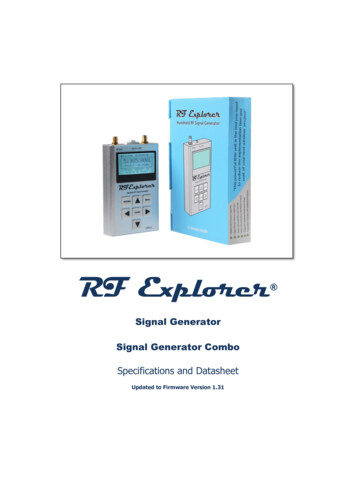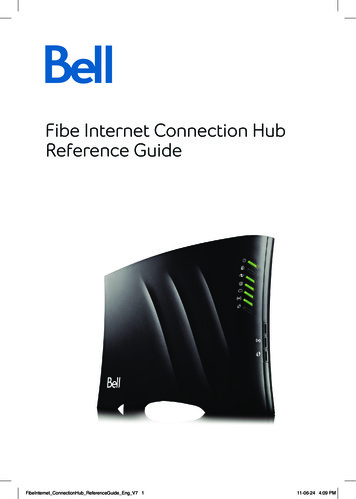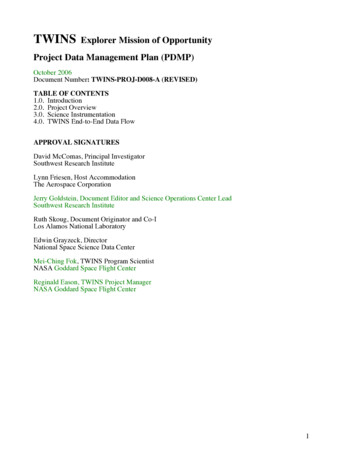
Transcription
TWINSExplorer Mission of OpportunityProject Data Management Plan (PDMP)October 2006Document Number: TWINS-PROJ-D008-A (REVISED)TABLE OF CONTENTS1.0. Introduction2.0. Project Overview3.0. Science Instrumentation4.0. TWINS End-to-End Data FlowAPPROVAL SIGNATURESDavid McComas, Principal InvestigatorSouthwest Research InstituteLynn Friesen, Host AccommodationThe Aerospace CorporationJerry Goldstein, Document Editor and Science Operations Center LeadSouthwest Research InstituteRuth Skoug, Document Originator and Co-ILos Alamos National LaboratoryEdwin Grayzeck, DirectorNational Space Science Data CenterMei-Ching Fok, TWINS Program ScientistNASA Goddard Space Flight CenterReginald Eason, TWINS Project ManagerNASA Goddard Space Flight Center1
TWINS PDMP ApprovalDavid McComasPrincipal InvestigatorSouthwest Research InstituteDateLynn FriesenHost AccommodationThe Aerospace CorporationDateJerry GoldsteinScience Operations Center LeadSouthwest Research Institute25 Oct 06DateRuth SkougDocument Originator and Co-ILos Alamos National LaboratoryDateEdwin GrayzeckDirectorNational Space Science Data CenterDateMei-Ching FokTWINS Program ScientistNASA Goddard Space Flight CenterDateReginald EasonTWINS Project ManagerNASA Goddard Space Flight CenterDate2
Revision History:AffectedRevisionSectionHeadingDescription of ChangeDateAllAll11/29/20003.1.3, 4.3.1Data AcqTable 4.1Changes to accommodate PI move from LANL toSwRI.Update number of direct events to reflect current ISDvalues.New TWINS Program Scientistadded Jerry Goldstein’s nameAdd Jerry Goldstein’s nameRevise projected launch scheduleAcknowledge probable overlap of TWINS 1 andIMAGE missionsAdd Oracle database discussionNew section discussing ancillary data productsMinor changes to cover pagesChange of title for J. GoldsteinRevise TWINS-1 launch and projected dataacquisition schedule, TWINS-2 projected launchschedule.Brief mention of sunlight exposure limitations.Discuss IMAGE satellite failure and revised TWINS-1solo operations and science.Revise Table 3.1New section added to discuss sunlight exposureanalysis"Data Delivery Hub Processing" List addedTWINS URL updated to current site.Update Table 4.1 (for Level 0 data), New Table 4.2(for Level 1 data)All mention of HDF format removed and replacedwith CDF.Update Level 0 Data description.Update Level 1 Data descriptionUpdate Level 2 Data descriptionUpdate Ancillary data descriptionUpdate to Archiving DiscussionUpdate Review ItemsChange numbering to Table 4.3 and Table 4.4Update discussion of NSSDC/SPDFAdd Reginald Eason as signees (at request of Holmes)June 2004Oct 2006Oct 2006Oct 2006Approvalscover pages1.22.0, 2.33.1.2.24.3.2, 4.3.4,4.4.1. 4.4.34.3.6Cover pages1.22.0, .54.3.64.4.04.4.54.4.3, 4.4.54.4.2Cover pages11/29/200011/29/2000June 2004June 2004June 2004June 2004June 2004Oct 2006Oct 2006Oct 2006Oct 2006Oct 2006Oct 2006Oct 2006Oct 2006Oct 2006Oct 2006Oct 2006Oct 2006Oct 2006Oct 2006Oct 2006Oct 2006Oct 20063
1.0. IntroductionThis document describes the Project Data Management Plan (PDMP) for the Two Wide-angle ImagingNeutral-atom Spectrometers (TWINS) mission. TWINS is a Mission of Opportunity selected underNASA’s Small Explorer (SMEX) program. The TWINS PDMP is designed to be consistent with theTWINS Program-Level Requirements Document (Appendix MO-2 of the TWINS Explorer ProgramPlan).1.1. Purpose and ScopeThis data management plan describes the generation and delivery of TWINS science data products,institutional responsibilities for data analysis, and the transfer of archival data products (including data,data documentation, and associated software) to the National Space Science Data Center/SpacePhysics Data Facility (NSSDC/SPDF). Covered in this plan are:1. Brief description of the instruments2. Description of the data flow3. Description of the science data products4. Processing requirements and facilities5. Policies for access and use of TWINS data6. Data product documentationIt is important to note that the TWINS telemetry system will be provided by the spacecraft sponsor,and thus a detailed discussion of this topic will not be included in this document.1.2. PDMP Development, Maintenance, and Management ResponsibilityThe TWINS Principal Investigator (PI), Dr. David McComas and Science Operation Center lead Dr.Jerry Goldstein, both at Southwest Research Institute, are responsible for the development,maintenance, and management of the PDMP throughout the TWINS mission. Data handling and datadistribution tasks are the responsibility of both LANL and SwRI personnel. Data analysis tools andcapabilities will be developed at both SwRI and LANL. The TWINS PDMP will be modified andupdated as required in accordance with the TWINS Configuration Management Plan.2.0. Project OverviewThe TWINS mission was selected as a result of AO-97-OSS-03 for SMEX missions. The Phase Bstudy began in July 1998. The mission Preliminary Design Review (PDR) and ConfirmationAssessment Review (CAR) were held on March 10, 1999. The mission Confirmation Review washeld on April 12, 1999, and TWINS entered Phase C/D in May 1999. The mission Critical DesignReview (CDR) was held on February 23, 2000. The TWINS Flight Model 1 (FM1) Pre-EnvironmentalReview (PER) was held on March 27, 2002 and a combined FM1 Pre-Ship Review (PSR) and FM2PER were held on August 24, 2004. The TWINS FM1 Mission Readiness Review (MRR) was held onAugust 23, 2005. The FM2 PSR was held on February 28, 2006, and the FM2 MRR on April 5, 2006.A final TWINS Mission Readiness Brief was successfully held at NASA Headquarters on May 23,2006.TWINS-FM1 was delivered to the Host contractor in early 2005 and launched successfully into orbit inthe summer of 2006. (The exact launch date is unavailable.) As of the writing of this document, highvoltage science data have not yet been acquired, although instrument high voltage turn-on could occurat any time. Based on the results of UV Sun exposure analysis (TWINS UV Exposure Study,Aerospace Report No ATR-2006(7687)-1), it may be early 2007 before we are in a optimal season forscience data acquisition. (See Section 3.3.)TWINS-FM2 was delivered to the Host contractor June 13, 2006 and is scheduled for launch in 2007,with the two-year stereo mission beginning in 2007 or 2008.4
2.1. Science ObjectivesThe overall scientific objective of the TWINS project is to establish the global connectivities andcausal relationships between processes in different regions of the Earth’s magnetosphere. TWINS willaddress this objective through stereoscopic neutral atom imaging of the magnetosphere from twowidely spaced, high-altitude, high-inclination spacecraft. By imaging charge exchange neutral atomsover a broad energy range ( 1–100 keV) using identical instruments on two spacecraft, TWINS willenable the three-dimensional (3-D) visualization of the magnetosphere and the resolution of large scalestructures and dynamics within the magnetosphere for the first time. In contrast to traditional in situmeasurements, TWINS will provide nearly continuous global, stereo coverage of the magnetosphere.Specific scientific questions to be addressed by TWINS include the structure and evolution of themagnetosphere and the sources, energization, transport, and sinks of magnetospheric plasmapopulations. The first level of questions will be addressed by the 3-D images themselves, and thesecond through inversion of the images to determine the characteristics of magnetospheric ions.2.2. Spacecraft DescriptionA description of the host spacecraft is not appropriate for the TWINS Mission of Opportunity. Weshall refer to these spacecraft as TWINS-1 and TWINS-2.2.3. Mission SummaryA summary of the TWINS mission is given in Table 2.1. Mission operations for TWINS will beprovided by the spacecraft sponsor. Each spacecraft will be placed in a Molniya orbit, and will bethree-axis stabilized and approximately nadir pointing.In nominal operating mode, the TWINS instruments will acquire image data with time resolution of 60seconds. Between each image, a 12-second period is required to change the actuator rotation platformtravel direction. No data will be collected during this time, giving a duty cycle for data collection of83%, and effective time resolution of 72 seconds.Table 2.1. TWINS Mission SummaryProject NameTWINSNumber of Spacecraft2Orbit DescriptionMolniya orbitInclination: 63.4 Apogee: 7.2 REPerigee: 1000 kmPeriod: 12 hoursApproximate Launch DatesTWINS-1: Summer 2006TWINS-2: Projected 2007 or 2008.Launch VehicleProvided by spacecraft sponsorNominal Mission Duration4 year design lifetime for each instrument2 year stereo missionPotential Mission LifeHost spacecraft have 7 year designlifetimeContinuous Data Acquisition Rate50 kbpsAttitude Control3-axis stabilizedTWINS will nominally operate only during the apogee portion of each orbit, when the spacecraft isabove the radiation belts. Operations are also planned for some perigee passes, providing low altitudeobservations when the spacecraft is below the radiation belts. Ultraviolet exposure analysis (TWINSUV Exposure Study, Aerospace Report No ATR-2006(7687)-1), based in part on UV calibration5
(TWINS Calibration Procedure, SwRI doc 1609-TCP-01) indicates that sunlight exposure willconstrain acquisition of science data such that observation windows will fluctuate with season. (SeeSection 3.3.)Telemetry for the TWINS mission will be received by the spacecraft sponsor, who will extract rawdata from the telemetry stream and send it to the Aerospace Corporation (henceforth Aerospace) forprocessing into Level 0 data. Level 0 data will then be sent to SwRI for processing of Level 1 data(images). These data products will be posted on the World Wide Web for use by the TWINS team, thescientific community, and the public, and will be provided to the NSSDC for archiving. Higher leveldata products will also be posted on the web and archived at the NSSDC, as appropriate.3.0. Science InstrumentationThe TWINS instrumentation consists of a neutral atom imager to obtain images of the Earth’smagnetosphere and a Lyman-α detector to measure the density of the neutral hydrogen geocorona.3.1. Neutral Atom Imager3.1.1. Instrument DescriptionThe TWINS neutral atom imager is based on the MENA imager developed for the IMAGE mission.TWINS combines two sensor heads to provide a field of view of 60 about the rotation direction (10 off nadir pointing). The instrument uses alternating biased and grounded collimator plates to rejectcharged particles and set the instantaneous azimuthal field of view. A carbon foil is used to producesecondary electrons for time of flight (TOF) measurement, and a position sensitive anode providesangular determination. Gold transmission gratings are used to block ambient ultraviolet light, to whichthe detectors are sensitive. Velocity analysis (from TOF measurements) combined with pulse-heightanalysis provides statistical mass determination. Since the spacecraft for this mission of opportunityare three-axis stabilized, the instrument will be located on a rotating actuator platform to provide 360 azimuthal coverage. Figure 1.1 shows the layout of the TWINS instrumentation package, includingthe ENA imager sensor heads, the rotating actuator platform, and the single electronics box.Figure 1.1. TWINS Instrument Layout3.1.2. Capabilities and Requirements6
3.1.2.1. Minimum Science RequirementsThe minimum performance requirements for the TWINS neutral atom imagers, taken from the TWINSProgram-Level Requirements Document, are given below. The neutral atom imagers on both TWINSspacecraft are required to meet these minimum requirements in order to provide a stereo neutral atomimaging mission.3.1.2.1.1. TWINS shall obtain at least 300 stereoscopic neutral atom images simultaneously from twoindependent spacecraft platforms over a period including at least 3 geomagnetic storms and/orsubstorms.3.1.2.1.2. Each TWINS instrument shall acquire images of the magnetosphere which cover a field ofview of at least 2 steradians centered about the nadir direction.3.1.2.1.3. TWINS shall measure the energy spectrum of magnetospheric hydrogen at energies from 1–50 keV with energy resolution of ΔE/E 1.0.3.1.2.1.4. TWINS shall resolve the development of substorms by measuring neutral atom images with12-minute resolution.3.1.2.1.5. TWINS shall measure the spatial distribution of magnetospheric hydrogen with resolution ofat least 12 x 12 for energies above 10 keV.3.1.2.2. Expected Performance LevelsTable 3.1 gives the expected performance levels for the TWINS neutral atom imagers. Thesespecifications are in agreement with the Baseline Science Requirements listed in the TWINS ProgramLevel Requirements Document. TWINS is designed to achieve a two-year stereo imaging mission. Asstated in the Baseline Science Requirements, all scientific goals can be met by the acquisition of atleast 3,000 stereoscopic neutral atom images simultaneously from the two TWINS spacecraft over aperiod including at least 30 geomagnetic storms and/or substorms. However, the TWINS mission planis to collect as much data as possible over both the two years of single spacecraft imaging and the twoyears of stereo imaging, and perhaps beyond if circumstances permit. It was originally hoped thatthere would be overlap between TWINS-1 and IMAGE satellite operations, allowing stereo imagingprior to the TWINS-2 launch. However, the IMAGE satellite stopped transmitting data in late 2005.Some failure scenario analysis suggests that in late 2007 when the IMAGE orbit precesses to bring thesatellite into full eclipse behind the Earth, a full power down and reboot will occur, and as a resultIMAGE might resume data transmission. However, given the uncertainty of this analysis, it is likelythat stereo imaging will not be possible until TWINS-2 data are available.3.1.3. Data AcquisitionThe TWINS neutral atom imager will nominally acquire data in only one science mode. The TWINSdata set will consist of two major products: 1) neutral atom images in energy, species, and angle space,collected and transmitted with 60-second time resolution every 72 seconds, and 2) raw position, timeof flight, and pulse height information for individual events (direct events data). To allow transmissionof a significant number of raw events (1253 events per 4 azimuthal bin (1.333 sec)), the image datawill be compressed from 16 to 8 bits before transmission, using a lossy compression scheme with errorof less than 3% for all instrument count rates. Details of the TWINS telemetry format can be found inAppendix D of the TWINS Interface Specification Document (ISD). Data from the two instrumentheads will be transmitted separately and combined on the ground, as will data from the two spacecraft.7
Table 3.1. Expected Neutral Atom Imager SpecificationsMeasurement TypeNeutral atom energy and compositionresolved imagesGeometric Factor0.020 cm2srPolar angle resolution4 FWHM for 10 keV hydrogenAzimuthal angle resolution4 FWHMInstantaneous FOV 60 x 2 FWHMTotal FOV 3.43 sr centered about axis 10º from nadirEnergy range1–100 keV hydrogenEnergy resolution ( E/E)0.4Mass identificationH, OTime resolution60 sec image / 72 sec cadenceUV rejection4 x 10-8 (MENA was in the range 10-6)Data Rate 50 kbps continuous data rate, 1/3 for image data, 2/3 for raw single events3.2. Lyman-α Detector3.2.1. Instrument DescriptionThe TWINS Lyman-α Detector consists of two independent sensors oriented at angles of 40 withrespect to the actuator spin axis. Each sensor has a FWHM field of view of 4 , defined by collimationhole baffles, uses Lyman-α interference filters as narrow band transmissions filters, and applies a KBror CsI photodiode for photon detection. The Lyman-α detector is located on the rotating actuatorplatform to provide full 360 azimuthal angle coverage. The Lyman-α detector is shown in theinstrument layout diagram given in Figure 1.1.3.2.2. Capabilities and RequirementsThe Lyman-α detector is not included in the minimum science requirements for TWINS as defined inthe TWINS Program-Level Requirements Document. Table 3.2 gives the expected performancecharacteristics of this instrument.Table 3.2. Expected Lyman-α Detector SpecificationsMeasurement TypeGeocoronal Lyman-αAperture Area3.2 cm2FOV4 FWHMWavelength1216 ÅWavelength resolution 50 ÅTime resolution60 sec / 72 sec cadenceSensitivity0.1-0.5 counts/sec/RData Rate40 bps continuous data rate3.2.3. Data AcquisitionLyman-α data are acquired in only one mode. Data from each sensor are collected in 90 azimuthalangle bins, each 2 wide (0.667 sec), with two Lyman-α azimuthal bins for each neutral atom imagerazimuthal bin. As is done for the neutral atom image data, a Lyman-α image will be collected with 60second time resolution every 72 seconds.3.3. Ultraviolet (UV) Sunlight Exposure Analysis8
Guided by the IMAGE MENA instrument response to sunlight at various imaging and spin angles,some limited ultraviolet exposure experiments were conducted as part of TWINS-1 and TWINS-2calibration (TWINS Calibration Procedure, SwRI doc 1609-TCP-01). Based on this measured angularresponse to UV, it is expected that during several months of the year, sunlight exposure will partiallyconstrain ENA observation times, and that this limitation will become severe for perhaps 1 to 2 monthseach year. Thus, we expect that each of the TWINS satellites will have "good" and "bad" seasons forobservation.Using TWINS calibration UV testing results (TWINS Calibration Procedure, SwRI doc 1609-TCP-01)and TWINS-1 ephemeris information, UV sunlight exposure analysis (TWINS UV Exposure Study,Aerospace Report No ATR-2006(7687)-1) indicates that TWINS-1 will view the Sun over extendedintervals near apogee during the North American winter ("bad" viewing season), and that NorthAmerican summer ("good" viewing season) is best for uncontaminated viewing. We do not have afirm projected launch date for TWINS-2, but it is expected that there will be sufficient overlap betweenthe respective optimal viewing seasons of TWINS-1 and TWINS-2 to achieve our science goals.Sunlight exposure studies will be updated periodically during the TWINS mission.4.0. TWINS End-to-End Data Flow4.1. OverviewFigure 4.1 shows the flow of TWINS data from the spacecraft through the archiving process. Thissection describes the processing steps required for the TWINS data. TWINS data will be obtained fromthe spacecraft through the spacecraft sponsor, who will forward the data to Aerospace for processing.Further processing will then be performed at SwRI, at LANL, and by other members of the TWINSteam. The resulting products will be made available on the TWINS web site, and will be forwarded tothe NSSDC for permanent archiving and public distribution. The TWINS team will maintain a webpage providing information about the TWINS mission, including information about data types andaccessibility. This web page is presently located at: http://twinstest.space.swri.edu/.The following list summarizes the various processes that will occur whenever data are delivered fromAerospace.4.1.1. Get the Level 0 Data (see Table 4.1): TWINS telemetry data, andAttitude and Ephemeris data will be acquired from Aerospace(every 7-14 days) on CD or DVD.4.1.2. SwRI will make a copy of the Aerospace CD/DVD and ship it toLANL for backup purposes.4.1.3. The Level 0 Data will be imported into the database (Section4.3.2), and validated.4.1.4. The Level 0 data will be read out of the database, put into CDFformat and transmitted (or shipped) to NSSDC.4.1.5. Lyman-α data files will be generated from the database.4.1.6. Summary plots will be generated and imported into the database.The steps 4.1.1—4.1.6 above need to be performed whenever new data are delivered to SwRI.Individual steps will need to be performed iteratively if we update plot times, formats, calibration lookup tables (LUTs), etc.4.2. Mission and Science Operations4.2.1. Telemetry Services9
Mission operations for TWINS, including spacecraft tracking, data downlink, and uplinkcommunications with the spacecraft, will be provided by the spacecraft sponsor. A detailed discussionof spacecraft telemetry is therefore not appropriate for this document.The spacecraft sponsor will receive the raw telemetry on the ground, and will extract the TWINS dataand provide it to a dedicated TWINS data processing system, referred to as the “TWINS GroundStation”, maintained by Aerospace. The spacecraft sponsor will also provide spacecraft attitude,ephemeris, and timing information to the TWINS Ground Station for inclusion in the TWINS data set.Aerospace will then be responsible for preliminary processing of the data, consisting of organizing theraw data by viewing direction and incorporating ephemeris and attitude data for the TWINSinstrument, and of preliminary storage and distribution of these data. The data produced by thisprocedure will be defined as Level 0 data. Starting from this point, all TWINS data will be open forscientific usage with no restrictions. Raw (pre-Level 0) data will be stored by Aerospace for the periodrequired to determine that Level 0 data are being generated correctly. The TWINS telemetry rate willbe 50 kbps. This data rate corresponds to an annual raw data volume (not including attitude andephemeris data) of 197.1 GBytes per year for each spacecraft.4.2.2. Mission and Science ControlBecause access to the TWINS spacecraft is done through the TWINS spacecraft sponsor, the TWINSmission is designed to require minimum contact with the ground. We intend that the instrument willfunction autonomously throughout its lifetime, and that at most times will operate in a single mode,reducing the need for instrument commanding. Instrument commanding can be accommodated by thespacecraft sponsor as necessary, and TWINS is designed to include test modes and safe modes, as wellas the nominal science data collection mode. During instrument turn-on and check-out, more frequentcommunication with the spacecraft will be available. Instrument health will be monitored throughexamination of both the housekeeping and science data by personnel at Aerospace, SwRI, and LANL.10
Figure 4.1. TWINS Data FlowTWINS SpacecraftInstrument commanding50 kbps data telemetrySpacecraft Sponsor Telemetry Mission operationsInstrument commandingRaw TWINS dataAerospaceAll data from this point on(Level 0 and higher) are openwithout restrictions and willbe available via the WWW. Level 0 processing Contact with S/C personnel State of health monitoringCommandchangesLANL Oversee development ofTWINS Science DataSystem Level 1 data processing Data analysis tool devel. Higher level data processing Combine data from two S/C State of health monitoring Science planningData,toolsSwRI Level 1 data processing Data distribution Data analysis tool devel. Higher level data processing Combine data from two S/C State of health monitoring Science planning Maintain TWINS web pageScience data productsOutreachLevel 0 dataArchivedataLevel 1 dataScience data productsTWINS Web SiteSciencedataScience data productsSciencedataLevel 0 dataLevel 1 dataNSSDC Data archiving Data Documentation Assoc. softwareSciencedataOther ScienceCollaboratorsTWINS Co-I Institutions11
4.3. Data Products4.3.1. TWINS Data SetThe TWINS data set includes scientific data collected by the instruments, instrument engineering andhousekeeping data, and instrument attitude and ephemeris data provided by the spacecraft. A detaileddescription of the data products can be found in Section 5.2.2 and Appendix D of the TWINS ISD.The TWINS data products are described in Tables 4.1 and 4.2.Table 4.1. TWINS Level 0 data products (See Section 4.3.3.)Data ProductDescriptionENA image dataSampled in 4 (1.333 sec) azimuthal pixels. Identified by sensor head("Onboard images")(2), species (3: H,He,O), polar angle (32: 4 bins), and quasilogarithmic-spaced time of flight (TOF) bins. Compressed from 16 to 8bits prior to transmission.ENA direct events ("DE") 5-byte data containing raw position, TOF, and pulse height informationdatafor valid particle events. Sampled in 4 (1.333 sec) azimuthal sectors.Up to 1253 events transmitted per sector in nominal operating mode.16-bit data sampled in 2 (0.667 sec) pixels. Identified by sensor (2).Lyman-α dataENA singles data26 16-bit counters, sampled every 1.333 sec. These parameters includestart, stop, and valid counts, as well as overflow counters used forengineering purposes.Instrument status dataInstrument status parameters which are tightly coupled to science data,and so are sampled every 1.333 sec. These parameters includeazimuthal sector identification, sector angular boundaries, and actuatorvoltages.Housekeeping dataInstrument parameters required less frequently than instrument statusdata. Sampled at least once per 60-sec scan in normal operating mode.Spacecraft ephemeris dataProvided by the spacecraft to the TWINS Ground Station. Positioninformation is required to within at least 500 km for high altitudeobservations, and to within TBD km for any perigee operations, andshall be provided with the highest resolution possible.Spacecraft attitude dataProvided by the spacecraft to the TWINS Ground Station. Knowledgeof the pointing direction of the TWINS sensor heads is required withresolution of at least 0.1 . Data shall be provided with time resolutionof 1 minute.4.3.2. TWINS Data ManagementTWINS data management will be accomplished using an Oracle database. This system allows flexiblestorage and searching capabilities, and is not tied to any specific data format. The Oracle database willbe accessed through a front-end user Web Interface (WI), described below. The WI will be used forbrowsing data, for analysis, and for transfer of data from SwRI to TWINS team members and thelarger scientific community. For archiving data at NSSDC, the baseline data format will be CDF (thecustomary data format used by NSSDC) for digital data, and JPEG or PNG for rasterized images. (Formore details, see Section 4.4.) Aerospace will mail DVDs of data to SwRI with an estimated latencyof two weeks or less. The format of the data will be as follows. TWINS telemetry data will be inbinary format defined by Aerospace (appendix D of the TWINS ISD). Ephemeris data will be inASCII text format defined by Aerospace.Table 4.2. TWINS Level 1 data productsData ProductDescription12
ENA direct events ("D.E.") Images created using the TWINS Image Maker (TIM) software,Imagesanalogous to Onboard Images, but created on the ground with moresophisticated look-up tables (LUTs) for binning and assigningfluxes, energies, and species.ENA D.E. Skymap ImagesENA D.E. images, mapped to geophysical coordinates andpresented in a "fish-eye" view, with the Earth in the center, dipolemagnetic field lines drawn in, and the Sun direction indicated.ENA Onboard Skymap Images Onboard images in geophysical coordinates as for D.E. images.Lyman-αParameterized Hydrogen geocorona model, a 30-parameter fit to observed LymanExospheric Model (PEM)α line-of-sight intensities. PEM should reproduce a full 3Ddistribution of hydrogen density.Summary PlotsVarious plots designed to give overviews of TWINS data.4.3.3. Level 0 DataThe basic TWINS Level 0 data product will consist of raw instrument counts data organized byviewing direction (both from the ENA imagers and from the Lyman-α detectors), as well as OnboardImages (See Table 4.1). This procedure will be carried out by Aerospace, using a data processingserver dedicated to the TWINS mission. Aerospace will then forward Level 0 data to SwRI (via DVDsor CDs, mailed) for further processing. Aerospace will delete Level 0 data from its local servers onlyupon confirmation that the current shipment of data has been received and validated by SwRI. TheLevel 0 data set will also include ENA imager single event data, instrument housekeeping data, andspacecraft attitude and ephemeris data. Level 0 data will be provided to SwRI as quickly as possibleafter transmission from TWINS to Aerospace, with an expected latency period of no less than one dayand no more than one week. Once at SwRI, Level 0 data will be quickly incorporated into the Oracledatabase and distributed to LANL and NSSDC for archiving (See Section 4.1). Analysis will beperformed to provide browse images as a primary TWINS data product. From ingestion of TWINScalibration data, the data ingestion process is estimated to have a latency of 10-20 minutes.4.3.4. Level 1 DataThe goal of Level 1 data processing is to produce a data product that can easily be used for scientificstudies. Level 1 processing will take raw (Level 0) data and create ENA images and a Lyman-αmodel.4.3.4.1. ENA ImagesLevel 1 processing will take raw ENA direct events (D.E.) data and create ENA images. LANL andSwRI have developed a software package called TWINS Image Maker (TIM) that uses look-up tables(LUTs) to bin D.E. data by angle, energy, and species, and to incorporate the instrument responsefunction. (The LUTs are based on calibration data, and will be updated as necessary, as the missionproceeds and we learn more about the data.) TIM creates images in instrument coordinates, and thenthe skymap procedure maps TIM images onto a geomagnetic coordinate view containing the Earth inthe center, with dipole magnetic field lines drawn in and the Sun direction indicated. TIM skymapimages can be easily compared to each other and to previous and complementary data sets.4.3.4.2. Lyman-α ModelLevel 0 Lyman-α data will be used to constrain a 30-parameter fitting function designed by theUniversity of Bonn to emulate the Hodges [1994] hydrogen density model of the terrestrial exosphereup to about 60,000 km (or about 10 Earth radii). The coefficients of this Parameterized ExosphericModel (PEM), along with the full 3D distribution they describe, will constitute Level 1 Lyman-α data.13
4.3.4.3. Level 1 Data Access and
Plan). 1.1. Purpose and Scope This data management plan describes the generation and delivery of TWINS science data products, institutional responsibilities for data analysis, and the transfer of archival data products (including data, data documentation, and associated software) to the National Space Science Data Center/Space
